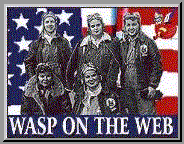| The GOSSPORT GAZETTE! | ||||||||||||||||
|
ISSUE #1 MEMORIAL DAY EDITION MAY 25, 1998 |
||||||||||||||||
Inside this issue:
The Gossport Gazette is not for profit.. Our goal is to shine a light on the WASP If you are interested in writing an article for the newsletter, let me know! Nancy Parrish, PASS IT ON! |
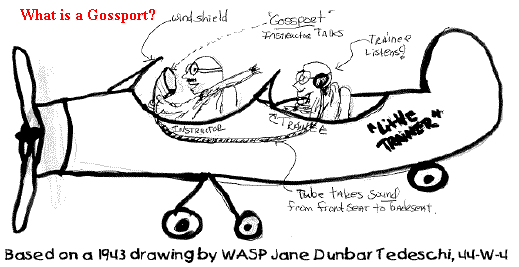 |
|||||||||||||||
|
On an overcast day in May, nearly 50 years after
the end of World War II, a Memorial Day procession of North Within
moments of takeoff, the distinctive sound of their engines can be heard
approaching my community. I rush outdoors to view the spectacular airplanes
that are like visitors from another remnant of time. These planes were the
Navy version of the United States Army Airforce, AT-6 "Texan", an advanced
trainer flown by nearly every American pilot during World War II… including
the
From my
backyard I watch the lofty parade of aircraft as their resonance slowly
begins to fade away. They remind me of the familiar music of another era. I
imagine the music of Glenn Miller or, maybe, Benny Goodman and visualize my
mother dancing with uniformed soldiers as a volunteer with On the first Mother's Day following my mother's death in the early 1980’s, I visited a mausoleum at the cemetery where she is laid to rest. As I walked down a dim hall, passing hundreds of names and dates inscribed on the walls surrounding me, I came upon the grave of a young woman interred beside her parents. It was both her youth and a bronze plaque that led me toward the square marble tablet that bore her name. The plaque contained the inscription:
I looked around at the enclosed surroundings which seemed like such an improbable place for a young woman to end up … and a WWII pilot who had died in the service of her country ? From a daughter's perspective, I felt sorry that this young woman never had the opportunity to share another Mother's Day with her mother again. As a recent college graduate, I wondered why I had never learned about or heard of the WASP in any history class prior to that moment.
Years
after my initial exposure to the story of the WASP, I discovered how Alice
Lovejoy died in pursuit training, flying formation in an AT-6. Through her
story, I gradually came to learn more about the Women Airforce Service
Pilots and while learning of their many outstanding achievements, I came to
discover how vital they were in assisting our country and the allies to
victory in WWII. Considered civil service, they were disbanded On Mother's Day of 1998, I returned with my family to the cemetery that I still visit, on days such as this. My daughters placed a small bouquet of flowers by Alice's marker, and with that, a small flag for Memorial Day. In the present, and now from a mother’s perspective, it is difficult to comprehend the magnitude of sorrow and loss that Alice’s mother must have experienced… because of the tragedy of war. In the quiet of that place, I close my eyes and visualize the airplanes that fly from my neighborhood on Memorial Day to commemorate the sacrifices of so many. I think of the lessons I’ve learned about dedication, perseverance and courage through women such as the WASP, and Alice Lovejoy. Like my own mother, it is the example of their lives that have inspired and continue to inspire me in ways they could never imagine….and those are the things that simply cannot be put into words. If you would like send an email for author
and tell her what you think of her article, PLEASE DO! We'll be happy to pass it on. ___________________________________ The WASP were deactivated in December of 1944...how they got home was up to their base commanders, the condition of the planes, and how much change they had in their pockets!
Come Home!" from a speech by
April 24, 1998 I want to just hit lightly on ...how well the Army took care of us., and I really appreciated it...because we were deactivated on December the 20th. I was in California. Word came down that the base commander should provide aircraft ...get the WASP as close to home as possible, and I thought, well, that's not too bad. The base I was on, they assigned a ...I didn't have any money. After we cleared the base I had a quarter. And I thought well, that's no problem, the Army will take care of us, after all it's only five days till Christmas. They'll be generous. A classmate said, "Well, I owe you ten dollars, so here's ten dollars." So, I left California with ten dollars and twenty five cents. We got as far as Las Vegas. First stop...and for some mysterious reason, most of these BT's just had to be grounded. And the two lieutenants said, "See ya later!" I lived in OPS (Base Operations), I slept in
OPS, I ate donuts till they were coming out of My mother spent over three hundred dollars... Christmas Eve, I didn't get any money and I'm in Akron. So...I called my mother...the last nickel. The ten dollars was long gone, and she says, "I can't help you," and I say, "we have an aunt here...we don't talk to her, but... do you think---- for the sake of the war..." So, she put me on a bus. Anyway, that's my story. It was nice talking to you. Good luck & happy flying!
__________________________ |
Over two years ago, I began working on a project to honor a unique group of pioneering Americans: the Women Airforce Service Pilots (WASP). I became interested because my mother is a WASP, but I have since become passionately committed, because I believe that role models should be remembered, their sacrifices honored, and their stories preserved to inspire future generations. These women made a difference. They should not be forgotten! THE NEED: Most Americans have never heard of the WASP.
After deactivation, many of their training records were unintentionally destroyed,
while the available military records of their service were sealed, marked
"classified" and filed away in government archives for 33 years. By that
time, the history of World War II had already been written, the WASP chapter either That's unacceptable. The Idea So, the questions were:
Well, as for question one, we're fortunate, because many of the eyewitnesses to the WASP history are still alive and well! (However, they are all over 70--time is critical!) They are scattered across 48 states, each with their own personal stories, records, scrapbook and memories. As for question number two, I was blessed with an incredible technical curiosity, and about three years ago, I discovered the INTERNET! No, we can't rewrite history, but we can make sure that this history is AVAILABLE for any and every one, any where in the world, including the computerized classrooms of the next century . We can make sure that this digital resource is as complete as possible. Many of these women have never told their stories. Many have never been asked. The Mission: Document, Digitize, Publish and Preserve the History of the WASP I realize there are some museums, libraries,
and Air Force bases who have limited exhibits, artifacts, and oral histories. That's
terrific! We'll link...we'll share information. However, their
Wings Across America will include a digital library, virtual museum and interactive learning programs to make the WASP history come alive, inspiring future generations to become the pioneers of tomorrow. Details of this project will be published as the Wings Across America on-line brochure-- within the next month. If you'd like more information sooner, please email me! ********************************** by Jacqueline Cochran reprinted from the Fifinella Gazette, March 1, 1943 The tribute to me in the first issue of The Fifinella Gazette touched me deeply and pleasured me no end. With the start of the war, I became
convinced that there was a sound, beneficial place for women in the air--not to compete
with or displace the men pilots, but to supplement them--and I never let up trying to
establish in practice the birth of my belief. I flew a bomber to England
partly to bring out the point, and partly to see what
the English women pilots were accomplishing and how they were
organized. Now, we are on the verge of seeing this whole dream blossom into reality in a truly big way. The Women's Flying Training program has already approached the proportions of our entire air program prior to the start of the war. What will be the ultimate result -- good or
bad -- will be up to the girls themselves. You of the first classes will have the
real responsibility. By your actions and results the future course will be
set. You have my reputation in your hands. Also, you have my faith. I have no
fear -- I know you can do the job. This work of mine -- planning, sitting at a desk, and working well into the night as regular routine -- is no great pleasure for one who loves to have her hand on the throttle; but, it has to be done if you are to succeed. My compensation can only come from your morale and accomplishments. -- I'm proud of you! ________________________ by Nancy Parrish The very least I can do is tell you a little bit more about my friend Shutsy. She probably won't like it. She is not comfortable being singled out. She likes to be part of the group...one of the gang. She is a gifted, talented and extraordinary WASP...yet, she is typical of so many other WASP. Shutsy didn't fly pursuits. She didn't fly bombers. She wasn't the first, and she wasn't the last, and thankfully, she didn't get killed in the line of duty. She was a member of the WASP graduating class of 44-W-5, just one of the 72 who graduated out of a class of 132. She didn't win any air races or set any records. Shutsy, like so many other WASP, just did her job. She followed orders, served her country, and then, when the WASP were deactivated, had to try to get home any way she could. Happy Memorial Day, Shutsy, God bless you all, every one, and God bless America! |
|||||||||||||||

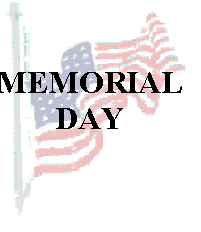
 the USO. She is one of countless American women allied on the home front,
assisting the war effort in any way that she can. She is in her early
twenties, independent and fun, confident and refined, and very much alive.
The memories of this era and her youth quietly reside within her for the
remainder of her life.
the USO. She is one of countless American women allied on the home front,
assisting the war effort in any way that she can. She is in her early
twenties, independent and fun, confident and refined, and very much alive.
The memories of this era and her youth quietly reside within her for the
remainder of her life.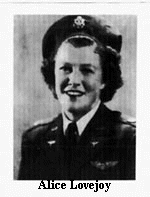
 BT-13. There were two of us...one going to Philadelphia, one to Pittsburgh.
Fine deal, two second lieutenants.
BT-13. There were two of us...one going to Philadelphia, one to Pittsburgh.
Fine deal, two second lieutenants.  my
ears. I took the twenty-five cents, changed it into nickels, and I spent my
time putting it in ... "Mom, I'm in Las Vegas. Could you send me fifty
dollars?" "Mom," I was somewhere else, you know, I forget where,
"could you send me fifty dollars?" She says, "I sent you fifty
dollars." I said, "Well, I didn't get it."
my
ears. I took the twenty-five cents, changed it into nickels, and I spent my
time putting it in ... "Mom, I'm in Las Vegas. Could you send me fifty
dollars?" "Mom," I was somewhere else, you know, I forget where,
"could you send me fifty dollars?" She says, "I sent you fifty
dollars." I said, "Well, I didn't get it."
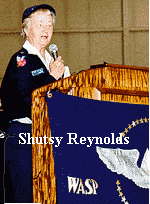
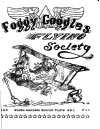 CLICK to see
CLICK to see 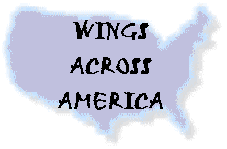
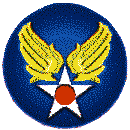 missing or only included as a brief footnote.
missing or only included as a brief footnote.  individual collections and
information are available only to the small number of people who are able to visit each
location. Wings Across America expands and enriches their efforts by creating a digital video
archive of the eyewitness testimonies of every surviving WASP and by putting all the WASP
information at the fingertips of anyone with a computer anywhere in the world!
individual collections and
information are available only to the small number of people who are able to visit each
location. Wings Across America expands and enriches their efforts by creating a digital video
archive of the eyewitness testimonies of every surviving WASP and by putting all the WASP
information at the fingertips of anyone with a computer anywhere in the world! Anything is possible...and with the support
of Baylor University (which we have)
Anything is possible...and with the support
of Baylor University (which we have)
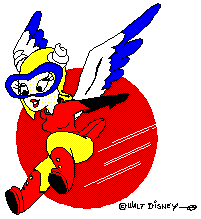 After graduation, I will be following
you with anxious and proud eyes, and your success will be my satisfaction.
After graduation, I will be following
you with anxious and proud eyes, and your success will be my satisfaction.